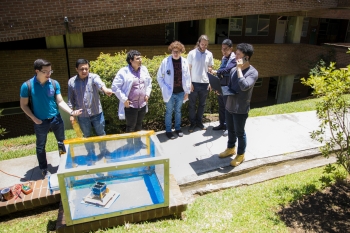Kansas public administration professor to lead ASU’s School of Public Affairs
[ad_1]
When members of the team that built the Quetzal-1 CubeSat watched their satellite take off on a SpaceX Falcon 9 rocket in 2020, it was the culmination of six years of hard work, overcoming financial and personnel hurdles, and challenging cultural barriers.
That hard work and ingenuity has garnered the team the CubeSat Delivery Prize award through Arizona State University’s Interplanetary Initiative. The award is just the latest step in the team’s remarkable journey.

Members of the Quetzal-1 CubeSat team test their satellite. The team, based at Universidad del Valle de Guatemala, undertook the project despite having no infrastructure, no industry experts at the university and no history of launching small satellites from that country.
Download Full Image
In 2014, a team based at the Universidad del Valle de Guatemala (UVG) decided to undertake an aerospace project despite having no infrastructure to do so. There are no graduate programs in aerospace in Guatemala and no history of launching small satellites from that country, and there were no industry experts at the university.
Two years before the team decided to build a CubeSat, they started with a more modest CanSat — a soda-can-size simulated satellite launched to a few hundred meters — but they were confident in their ability to think bigger.
“It seemed like a really challenging project. The natural step would have been choosing to make a high-altitude balloon after the CanSat. But we were really confident in the work we did on the CanSat. We were really happy with the results, so we decided to take a higher risk and get into CubeSats,” said Jose Bagur, the head of hardware on the project who was an undergraduate student when the project started.
A CubeSat is a class of miniature satellites roughly the size of a loaf of bread.
Difficult beginnings
The team started working on the project in different laboratories and the UVG cafeteria. There was no lab space that could be dedicated to a project like this so they looked for somewhere with a lot of electrical sockets. Still, morale was high among this early group.
“The first year with the first group of students, we were motivated because we were doing something new and learning a lot,” said Victor Ayerdi, the co-director of the project.
However, as time went on and the possibility of a successful completion for the project remained uncertain, student recruitment became more difficult.
“At one point, one of the students said, ‘No, I want to do my senior project on something I know is going to be done, not on something that is not going to be done.’ There was simply not enough motivation to do it because a lot of people didn’t trust that this was going to be possible, and, to be honest, we couldn’t say, ‘Yes, we’re going to do this, we’re going to finish’ at that point because it was difficult for us to see the future,” Ayerdi said. “It was like that for three years. After three years, it was getting harder to continue because the motivation was difficult.”
UNOOSA/JAXA KiboCUBE award boosts morale
Two years in, funds to complete the project had also become a challenge. The team started looking for funds in 2016. They attracted one donor who gave $5,000, which barely made a dent in what they needed, and their applications to several other funding competitions were unsuccessful. Finally, their fortunes turned.
“The main reason we could continue was because we applied at the beginning of 2017 to the KiboCUBE program of the United Nations Office for Outer Space Affairs and JAXA,” Ayerdi said. “At that point, after three years of work, we had a design of a CubeSat. It needed a lot of improvement, but we had a design.
“One of the criteria to apply was that the country had never launched a CubeSat into space and the country hadn’t had the capability to do it, so we were the ideal candidate. We were selected as winners, and that changed the history of the project because before KiboCUBE it was difficult for us to convince students that this was going to be possible.
“After we were announced as winners, we had a waiting list of students who wanted to be involved in the project. That was nice because it gave us the credibility that was difficult to have before that.”
Quetzal-1 team takes its message public
The KiboCUBE award gave the team the opportunity to deploy Quetzal-1 from the International Space Station and covered the cost of transporting the satellite to the space station, but money for CubeSat components was still an issue. They set out to gather public support.
They pitched a series of articles to the one of the biggest newspapers in Guatemala, Prensa Libre. The newspaper staff threw its full support behind the team, incorporating infographics and multimedia elements into the articles. The team published 55 articles over two years.
“One of the most impactful articles came out in Women’s Day magazine. We had few women, which happens in engineering, and at that point we realized we could also use the project to motivate women to study engineering because even though they were few in the team, maybe 10%, they were really enthusiastic and motivated,” Ayerdi said.
It was also through these publications that the project got its name. The newspaper ran a “name the satellite” contest. The winner was a high school student who suggested the name quetzal, which is the national bird of Guatemala and a symbol of goodness and light.
Because of these publications, word of the project reached the UK Space Agency, which offered to cover the costs of some of the testing. The team also received support from several other international and national organizations, and UVG covered the remaining 30% of the costs.
[ad_2]
Source link